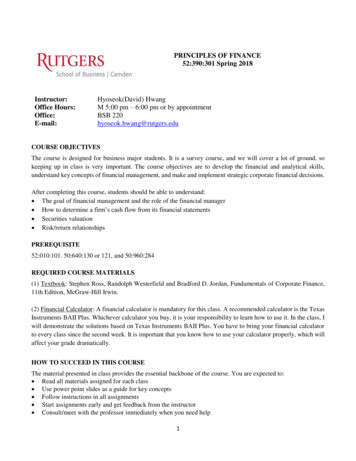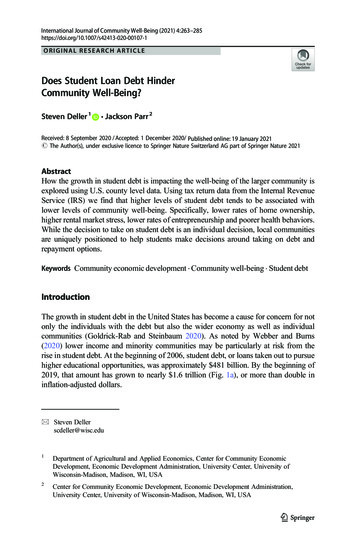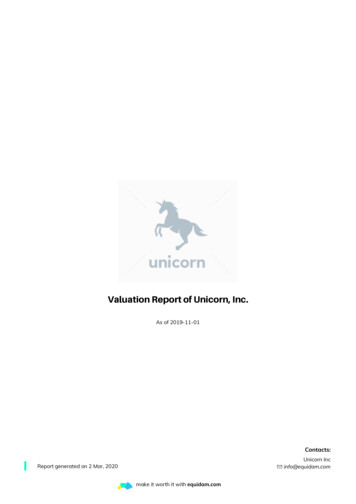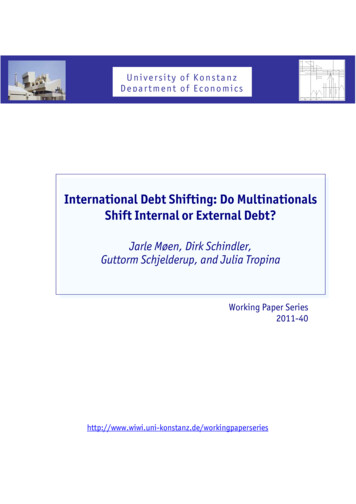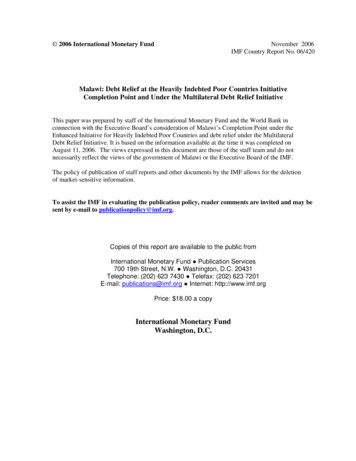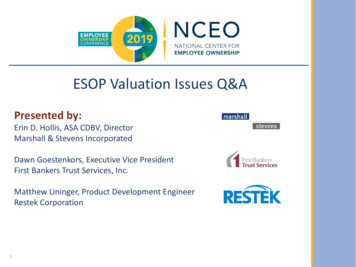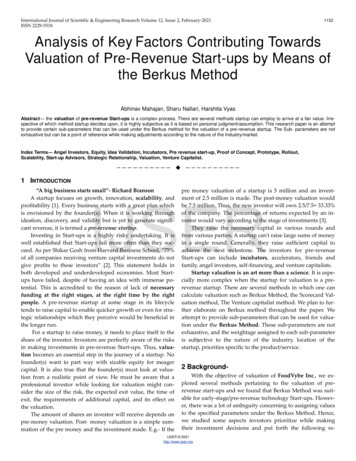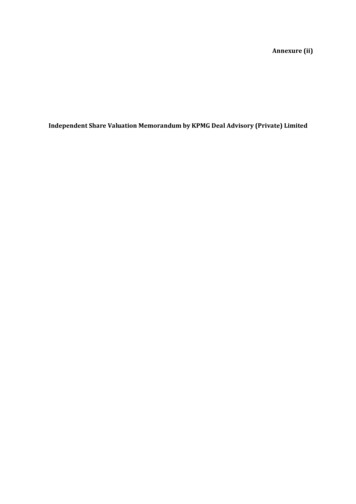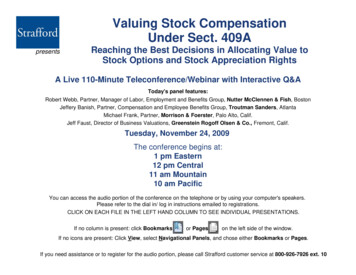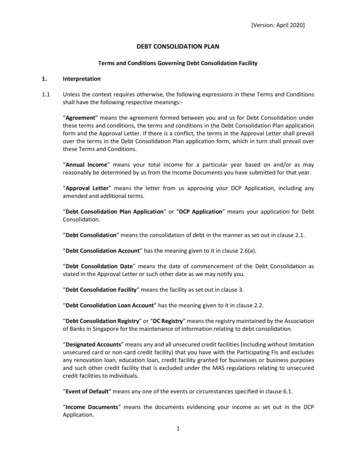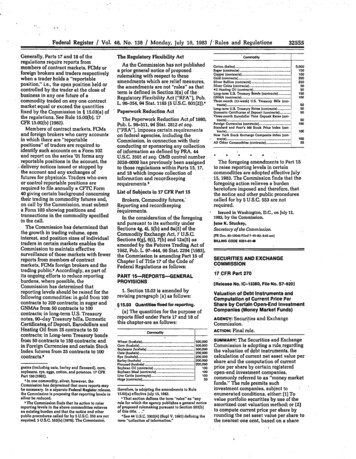
Transcription
'., FederalRegister. ',IVol. 48,No.t38 / Monday,July 10, 1983.'Generally, Parts 17 and 18 of theregulations requite reports frommembers of contract markets, FCMs' orforeign brokers and traders respectivelywhen a trader holds a "reportableposition," i.e., the open position held orcontrolled by the trader at the closB ofbusiness in any ami future of acommodity traded on anyone contractmarket equal or exceed the quantitiesfixed by the Commission in § 15.03(a) ofthe regulations.'See Rule 15.00(b), 17CFR 15.00(b) (1982).Members of contract markets, FCMsand foreign brokers who carry accountsin which there are "reportablepositions" of traders are required toidentify such accounts on a Form 102and report on the series '01 forms anyreportable positions in the account. the. delivery notices issued or stopped bythe account and any exchanges offutures for physicals. Traders who ownor control reportable positions arerequired to file annually a CITC Form40 giving certain background concerningtheir trading in commodity futures and,on call by the Commission, must submita Form 103 showing positions andtransactions in the commodity specifiedin the call.The Commission has determined thatthe growth in trading volwne, openinterest. and position sizes of individualtraders in certain markets enables theCommission to maintain effectivesurveillance of those markets with fewer.reports from members of contractmarkets. FCMs foreign brokers and thetrading public.2 Accordingly. as part ofits ongoing efforts to reduce reportingburdens. where possible. theCommission has determined thatreporting levels snould be raised for thefollowing commodities: in gold from 100contracts to 200 contracts; in sugar andGNMAs from 50 contracts to 100contracts; in long-term u.s. Treasurynotes, 9O-day Treasury bills. DomesticCertificateaof Deposit, Eurodollars andHeating Oil from 25 contracts to 50contracts; in Long.terin Treasury bondsfrom 50 contracts to 150 contracts; and,in 'FQreign Currencies and certain StockIndex futures from 25 contracts to 100contracts. 2grains (Includhig oata. barley and naxseed). com,soybeans. rye. eggs, cotton, and potatoes. 17 CPRPari 160 (1982). In one commodity. silver. however. theCommission has deterrninedthat more repOriS maybe necessary. In a separate Federal Register release.the Commission Is proposing that-reporting levels insilver be reduced. The Commission finds that Its apllon to raisereporting levelsln the above commodities rellevesan exlsllng burden and thai the nollce and otherpublic procedures callsd for by 5 U.S.C. S53 are notrequired. 5 U.S.c. 553(b) (1976). The Commission."rRules and RegulationsThe Regulatory Flexibility ActAs the Commission has not publisheda prior general notice of proposedrulemliking with respect to these,.amendments which are relief measures,the amendments are not "rules" as thatterm is defined in Section 3(a) of theRegulatory Flexibility Act tURPA"). Pub.L. 96-354, 94 Stat. 1165 (5 U.S.C. 601(2)).'Paperwork Reduction Act,.The Paperwork Reduction Act ,of 198D,Pub. L. 9 511, 94 Stat. 2812 lit seq.("PRA"), iniposes certain requirements'on federal agencies. including theCommission, in cOllnection with theirconducting or sponsoring allY collectionof information as defined by PRA. 44U.S.C. 3501 et seq. OMB control number.3038-0009 has previously been assignedto those regu:Iations within Parts 15, 17.and 18 which impose collection ofinformation and recordkeepingrequirements.'.List of Subjects in 17 CPR Part 15Brokers, Commodity futures .Reporting and recordkeepingrequirements.10 the consideration of the foregoingand pursuant to its authority tihderSections 4g. 4i, 5(b) and 8a(5) of theCommodity Exchange Act, 7 U.S.C.Sections 6(8), 6(i), 7(b) and 1Za(5) asamended by the Futures Trading Act of1982. Pub. L. 97-444, 96 Stat. 2294 (1983).the Commission is amending Part 15 ofChapter I of Title 17 of the Code ofFederal Regulations as follows:PART 15-REPORTS-GENERALPROVISIONS1. Section 15.03 is amended byrevising paragraph (a) as follows:§ 15.03 Quantities fixed for reporting.(a) The quantities for the pUrpose ofreports filed under Parts 17 and 18 ofthis chapter-:ue as follows:Whe.t (bu.h.Ia)500.000Com (bu.hel.). . 500.000Soybe.n. (bu.h.l.) .,.500.000"', 200,000Osl8 (bu.h.I.)Ry. (bu.h.l.).200.000Berl.y (bu.h.I., ., , ,, ,.200.000,200,000Fl.xseed (bush.lal,.:. . .100Soybeon Oil (contrecl.l ,Soybe.n Me.l (oontr.ct.).100Uv. Cattl.(conlra I.). 100Hogs (c.nlr.cl.), ,.50therefore. is odopllng the amendments to Rule15.03(0) erfectlve/u1y 15. 1983. Thst secllon defines the term "rules" as "anyrule for which Ihe agericy publl hes B general noticaof proposed rulemaking pursuent to Secllon 553(b)of this 1iI1e."'See 44 U.S.C. 3502(4) (Supl V.19Bl) defining thaterm "collection oflnformation,"32555. ComniodityCott n (billes) ; , , ,; . .Sugor lc.nlraclI)Copp.r (c.ntr.ct.),,Gold (oonlract8),,".,Sliver Buill.n \c.ntracli) .Sliver Coin. (caillracll) :.#2 Heating Oil [cantr.ct.).,,,.Long·teno U.S. TreS8Ury Bond. (oonlraclll.GNMA (cantract8),"Three·manth (13.week) U.S. Trea8ury BUI. (con·lract.).Long·I."" U.s. Tre8Bury Not.8 (c.ntrect8),Dome.Uc certlfical of,Deposil (contrac.).Thro.·month Eurod.lI.r Time O.p 11 R.te. (con.tracI8),;, ,P.relsn Currencle. (oontract.l,. .St.ndsrd .nd Poor'. 500 Slock PrIce Ind.x (con.tr.ct.),New York Stock Exchange Compo.lte Ind.x (con.tract8).All Other COmmodltl (c.ritr.cl.):.5.000100100200. 250505015010050505050tOO10010025 The foregoing amendments to Part 15to raise reporting levels in certaincommodities are adopted effective July15,1983. The Commission finds that theforegoing action relieves a burdenheretofore imposed and therefore, thatthe notice and other public procedurescalled for by Ii U.S.C. 553 are notrequired.Issued In Washington. D.C. on July 12,1983. by the Commission.JaDe K. Stuckey,Secretary ofthe Commission.(PR O.c. 19345 Piled 7-15-l13; 8;45 8m]BIlLING CODE 8351.01-11SECURITIES AND EXCHANGECOMMISSION17 CF.R Part 270[Release No. IC-13380. File -No. 87-920]Valuation of Debt Instruments andComputation of Current Price PerShare by Cert8Jn Open-End InvestmentCompanIes (Money Market Funds)AGENCY: Securities and ExchangeCommission. .ACTION: Final rule.The Securities and ExchangeCommission Is adopting a rule. regardingthe valuation of dllbt instruments, thecalculation of current net asset value pershare and the computation of currentprice per share by certain registered, open.end investment companies,commonly referred to as "money marketfunds." The rule premits suchinvestment companies, subject toenumerated conditions. either: (1) Tovalue portfolio Bllcurities by use of theamortized cost valuation method: or (2)to compute current price per share byrounding the net asset value per share tothe nearest one cent, based on a shareSUMMARY:
32556Federal RegisterIVol. 48. No. 138value of one dollar. Previously, theCommission granted individual orders ofexemption to permit use of those,valuation or pricing methods. The ruleobviates the need for most, if not all. ofsuQh applications.EFFECTIVE DATE: July 18. 1988. "FOR FURTIiER INFORMATION CONTACT:H. R. Hallock. Jr., Special Counsel (202 272-3030). or Gene A. Gohlke. ChiefFinancial Analyst (202-272-2024).Division of Investment Management.Securities and Exchange Commission.450 Fifth Street. Washington. D.C. 20P49.SUPPLEMENTARY INFORMATION: TheCommission is adopting rule 2a-7 [17CFR 270.28-7} under thelnvestmentCompany Act of 1940 ("Act") [15 U.S.C.8Oa-l et seq.} to permit. subject tospecified conditions, certain open-endinvestment companies, known as"money market funds." to compute theircurrent price per share for purposes ofdistribution. redemption and repurchaseby using either: (1) The "amortized cost"method of valuation to value their 'portfolio instruments for purposes ofcalculating their current net asset valuepeI: share; or (2) the "penny-rounding"method of computing their current priceper share.Under the amortized cost method ofvaluation. money market funds maycalculate their current net asset valuefor use in computing the current price oftheir redeemabl securities by valuingall portfolio securities and assets.regardless of whether market quotationsare readily available, 'at the acqUisitioncost as adjusted for amortization ofpremium or accretion of discount ratherthan at current market value as wouldbe required by rule 28-4 under the Act.[17 CFR 270.2a-4}.Under'the penny-rounding method ofcomputation. money market fundscalculate their current net asset value inconformance with rule 28-4 by valuingportfolio securities for which marketquotations are readily available atcurrent market value. and other ',securities and assets at fair value asdetermined in good faith by the board ofdirectors. However, they may thencompute the current price of theirredeemable securities by rounding the 'net asset value per share to the nearestone cent on 8 share value of one dollar.Rule 2a-7 provides that in order to useeither of the above valuation or pricingmethods a money market fund mustcomply with certain conditions. Thoseconditions basically: (1) Limit the typesof investments that the money marketfund can make to short-term. highquality debt instruments; (2) impose onthe board of directors (trustees in the'case of a trust; hereinafter referred to asIMonday. July 18. 1983"board of directors" or "board") of themoney market fund a special obligationto ensure that a, stable price pet share ismaintained; and (3) require that theboard of directors of the money marketfund. in good faith. determine thatit is inthe best interests of the.fund and itsshareholders·to maintain a stable netasset value or price per share and thatthe money market fund will discontinueits use of either method if such method ,ceases to reflect fairly the market-basednet asset value per share. In addition. amoney market fund using the amortizedcost method of valuation must monitorthe deviation between the price of itsshares computed frOm a net asset valueper share calculated using amortizedcost values for its portfolio instrumentsand the net asset value of such sharescalculated using values for portfolioinstruments based upon current marketfactors. If such deviation exceeds Y2 ofone p rcent of the price per share or ifthe amount of deviation may result inmaterial dilution or other unfair results, to shareholders. the rule imposesspecific obligations on the board ofdirectors to respond to the situation.Likewise, a money market fund usingthe penny-rounding method to computeits price per share may have to monitorin a similar fashion the valuation ofthose portfolio instruments withremaining maturities of sixty days orless I that are valued at amortized costin order to assess the fairness of thatvaluation method.'The reasons for proposing rule 2a-7and the administrative history of therule are discussed thoroughly inInvestment Company Act Release No.'12206 (February 1. 1982) ("Release12206"). 47 FR 5428 (February 5, 1982). Inbrief. the rule generally codi(ies thestandards that were developed forgranting the applications filed by moneymarket funds for exemption from thepricing and valuation provisions of theAct. with a slight expansion of the typesof instrumen s permitted for purchase.Persons interested in a more detaileddiscussion of the genesis ,of the ruleshould refer to that release.Rule 2a-7 is designed to obviate the,need for individual money market fundsto file applications for exemptive ordersto permit the use of either penny rounding or amortized cost methods. Inaddition. the Commission recognizesthat money market funds with existingexemptive orders may wish to rely onthe rule rather than their individualorders. The Commission has noobjection to money market fundsceasing to rely on their iI)dividualexeI{lptive orders and using instead rule See foolnote 44. infra.IRules and Regulations2a-7 as the basis for their pricing orvaluation method. provided that theboard of directors of any such moneymarket fund approves the change andthe fund makes any necessarydisclosure to shareholders.-In addition.rule 28.-7 is designed to clarify theobligations of money market funds andtheir boards of directors when usingeither the amortized cost Or penny rO}lnding method. As stat d in therelease proposing rule 2a-7. the rule isnot intended to expand theresponsibilities and liabilities imposedupon directors beyond those imposedunder the exemptive orders. Guidanceprovided by this release should beconsidered generally applicable to amoney market fund operating pursuantto an exemptive order or pur uant torule 2a-7.In response to its requests for,comments. the Commission received 21letters. The commentators universallyagreed that proposed rule 2a-7 shouldbe adopted. with certain amendments. Anumber of commentators, however.expressed strong objections to some ofthe positions'taken by the Commission'in Release 12206. Those objections andthe Commission's response arediscussed in detail below. As a result ofits consideration of the comments, theCommission has determmed to adoptrule 2a-7. subject to severalmodifications of the proposal. and toissue this release, which will serve.rather than Release 12206, as the,operative interpre ive vehicle.DiscussionUnder rule, 2a-7, investmentcompanies that have investmentportfolios consisting entirely of U.S.dollai-denominated short-term debtobligations ("money market funds") The Corrtmission received a comment that therule should be amended to include this definition ofa money market fund. The description has not beenadded as a definition under the rule be,cause it isnot an exclusive definition of a money markel fund.The role permits only an investment company thathas the requisite' port olio [eo8 entirely U.S. dollar denominated short-tenn debt obligation's) to replyupon it; provided thaI all the conditions of the ruleare aaiisfied. The Division of InvestmenlManagement has recently token the position that itwould not object If a money market fund utilizing anamortized cost exemptive order invests. withincertain limitations. in shares or units of otherInvestment companies which invest primarily in' ,high quality, short-lenn municipal instr"ments andwhich determine their net esset value based on theamortized cost Dr p nny.roundin8 methods inreliance on Commission exemptive ordera Drproposed rule 2a-7 under the Act when it is 'adopted. See leller from Gerald Oshero f. AssociateDirector. Division offnveatment ManagemenltoJohn J. Scoll. Esquire. on bebalfgfThe BenchmarkTaX-Exempt Fund. doled June 28; 1983.
Federal RegisterIVol. 48, No. 138IMonday. July 18. 1983IRules and Regulations32557 .the nearest one cent of a dollar whenmay use either the penny-roundingCommission recognizes that such acomputing its price per share. 1ipricing method or the amortized costrequiremen 'Yould be inefficient.andvaluation method for purposes ofunrealistic. Therefore, in an effort toThe Commission received acomputing their price per share on thei.rclarify its' position. the Commission hassubstantial number of commentsnet asset value per shax:e. respectively,modified somewhat the language of theexpressing the view that money marketprovided that they comply with therule, as discussed hereinafter.funds uS,ing the amortized cost valuationconditions enumerated in the rule.method should be permitted to penny The rule. like the prior exemptiveThose conditions are designed to ensure orders, specifically states that the board round when computing their price perthat any money market fund that adopts .shall be responsible for certainshare. These commentators. argued thatone of the-above procedures in an effortfunciions, such as monitoring the valuewithout the ability to penny-round,to maintain a stable price per share willfunds using the amortized cost valuationof the portfolio and determining thebe able to maintain that stable price.method 'would be .disadvantaged, andquality of its instruments. While theThe conditions contained in the rule,that the % of 1 percent limitation on theboard retains the final responsibility foras well as those conditions found indeviation of the price away from thethe operations of the fund and theindividual exemptive orders, provide for' specific procedures required by the rule,market-based net asset value per sharea special system of safeguards to protect the rule does not preclu'de the boardwould limit the amount of rounding tothe fund. The responsibility forthe equivalent of that used by funds'from delegating duties and functions (todesigning and effectuating that system is be carrfed out under its supervision) tounder the penny-rounding method. Afterplaced on the board of directors. As athe investment adviser. This release setconsidering these comments, thepart of that system of safeguards, theforth in detail some methods by whichCommission has determined that it isdirectors have undertaken the specificappropriate to permit funds using thethe board'may delegate certain.responsibility of monitoring the marketamortized cost valuation method toresponsibilities,and still be deemed tovalue of the portfolio, in the case ofround to' the extent permitted to funds.be in compliance with the rule. Thesefunds using amortized cost valuation,opting to use the penny-roundingexamples are not intended to be theand have represented that the fund wiIl . exclusive method of compliance.method, i.e., the deviation between thelimit iitvestments to those instrumentsHowever. they are meant to set forth the .price per share and the market basedwhich the board deems to meet certainnet asset value per share may notCommission's view that a delegationcriteria. Some commentators opined that will not be deemed satisfactory whereexceed 1fz of 1 percent.such responsibilities should be placedthe board's only participation is anWhile the Commission is proposing toon the investment adviser rather thanapproval after the fact. The Commission perinit a fund using the amortized costthe board of directors. While thebelieves that, at a minimum, the boardvaluation method to round its net assetCommission realizes that, as a practicalshould have knowledge in advance ofvalue per share beyond ine extentmatter, board of directors may lackhow the functions will be performed byconsidered material as set forth intechnical expertise and must rely on thethe investment adviser; the board should . Investment Company Act Release No.investment adviser to provide factualassure itself that such methods are9786 (May 31, 1977) ("Release 9786"), 42information and adv.ice, it believes thatreasonable and provide any guidanceFR28999 (June 7, 1977) 8 in computing itsthe final responsibility for the fund'snecessary: and finally, the board shouldper share, it emphasizes thepriceoperations should remain with the board review periodically the investmentresponsibilities of the board when suchof directors. The Commission bases itsadviser's performance.a method is used. A basic premisedetermination on the facUhat the boardThe rule also provides. under bothjustifying the use of the amortized costis traditionally the fund's ultimatemethods,Jor the computation of a sharevaluation method is the fact thatauthority. as well as the possibility ofpripe that will represent fairly thesecurities held until maturity wUIinherent conflicts between the interestscurrent net asset value per share of theeventually yield a value equivalent toof the investment adviser and those ofinvestment company, thus reducing anythe amortized cost value, regardless ofthe funds. Accordingly, the rule aspossibility of dilution of shareholders'thecurrent disparity between amortizedadopted continue to place ultimateinterests or other unfair results. 3costvalue and market value. Thus. theresponsibility for fulfilling the conditionsRule 2a-7 provides that money market Commission is willing to permit funds toof the exemptive relief on the board ofuse amortized cost valuation so long asfunds satisfying the necessarydirectors.'the disparity between the amortizedconditioiisinayuseeitherthepenny Iii statmg that certain functions arecost·value and current market valuerounding or amortized cost method. Inthe responsibility of the board ofremains minimal. Funds using theRelease12206theCommissionstateddirectors, the rule does not require thatamortized cost valuation method.maythat whil a fund which had elected onethe board personally become involvedneed to use penny-rounding inof the methods was not foreclused fromin the day-to-day·operations of the fund.computing their price per share when aswitchingtoanothermethod,"therulenor does the rule require the Doard to begain or a loss in the value of theirwould not permit a fund to use bothan insurer of the fund or the fund'sportfolio,.which was not offset againstmethods at the same time, i.e., theinvestment adviser. The Commissionearnings, is recognized. Where the gainamortizedcostvaluationmethodtosought in Release 12206 to clarify,oiloss has been recogn zed. there is nocalculate its net asset value per sharethrough examples, that the board couldlonger merely a potential for a deviationand rounding of that net asset value todelegate certajn day-to-day fu ctions tobetween the value assigned by the fundthe investment adviser and still be infor the securities sold and that actually'If shares are sold based on a nel assel valuecompliance with the rule. However,which lums oullo be eilher understated orrealized by the fund. The Commissioncomments received in response to theoverstated tn comparison to Ihe amount al whichdoes not wish to define the premissibleporifolio inveslmenls could have been sold, thenrule proposal indicated rnewconfusion by some parties who were See fool nota 5 or Release 12206.investors will have been diluted. concerned that the rule would require Relesse 9786 setsthe.amounl or less Ihan %0 of Prior 10 any such switch. the board of diroctorsonecenl on a share value of one dollar as thethe board personally to carry out theshould approve such acllon and any necessarybenchmark for materiality.disclosure should be made 10 shareholders.day-to d8Y oper8tio s of the fund. The
32558Feder!!l RegisterIVol. 48. No, 138amount of deviation. H,owever, to theextent a fund has realized gains orlosses that cause the fund's price pershare to deviate from the amortized costnet asset value per share. the boardmust be particularly careful to ensurethat the fund can maintain a stable priceper share. The fact that a fund maypenny-round while utilizing amortized cost valuation does not, of course,diminish the board's responsibility tomonitor the market-based net assetvalue. nor does it increase thepermissible deviation between shareprice and market-based asset value.Permissible Portfolio investmentsThe rule, like the previously grantedexemptive orders. is designed to limitthe permissible portfolio investments ofa money market fund seeking to use·either penny-rounding or the amortizedcost valuation method to maintain 8stable price per share to thoseinstruments that have a low level ofvolatility" and thus will provide agreater assurance that the moneymarke.t fund will continue to be able tomaintain a stable price per share thatfairly reflects the current net asset valueper share of the fund. Accordingly, "'money market funds relying on the rulemay purchase only those portfolioinstruments which meet the quality andmaturity requirements of the rule. 8 Therule. however, would not prohibit amoney market fund 'from holding cashreserves. It should be noted that the ruledoes not speak to the acquisition orvaluation of puts or stand-bycommitments by a money market fundwishing to use th subject'valuation or7 There are'\)8sically two types of risk whichcause fluctuations In the value of money marketfund portfolio Instruments: tbe marlcet risk. whichprimarily results from fluctuationsIn the prevailinginlerest rate. and the credit risk. In generalInstrumenlll with shorter periods remaining untilmaturity and which are of higber qualily havercducod marketand credit risks and thus tond 10nucluate less in vatue over time than instrumenlswith longer remaining mat!Jritles or of lesser quality.s The applications for exemptive relief baveroutinely sol Co!1/! the specific types and quality oCinstruments in which money market funds couldinves!. The inslrumonlll consisted exclusively oCdebt obligations. including such inslrumenlllastreasury bllis and notes and other governmentissued or guaranteed debt securities. certificates oCdeposit and lime deposits from domestic banks andthrift institutions and from foreign banks. bankers'acceptances of domestic and foreign banks.commercial papar. corporato bonds and notes andrepurchase agreements on other deht obligations.Whilo the rule doos not set out the various types ofdebt inslrumonts in which a money market fundrelying on the rule may invesl, the rule does requirelhat all portfolio instruments mature In ono year orloss and be of high quality. The types of instrumontsa particular fund may invest in are. of course:fUrlher limited by its choice of investment policy.See also. foolnote 2. supra.IMonday, July 18, 1983pricing mllthods. 9 The Commission hasgranted exemptive orders to permit theacquisition of puts. but thus far, onlyunder limited circumstances and subjectto certain conditions. 10 Accordingly. afund requiring exemptive relief in orderto acquire puts or standby commitmentsmust still seek an individual exemptiveorder. If in the future the issues 'concerning the acquisition of puts areresolved, the rule may be amended.Maturity ofPortfolio InstrumentsA money market fund may rely on therule only if its enUre investmentportfolio consists 9 instruments with aremaining maturity of one year or less.As prescribed in the rule, which isgenerally a codification of positionstaken by the Commission regarding theconditions contained in the exemptiveorders, the maturity of an instrumentgenerally is deemed to be its statedmaturity, with 8 special exceptionprovided for certain variable andfloating rate paper. Accordingly, aninstrument is deemed to satisfy the oneyear or less maturity requirement forpurposes of the rule if. on the date ofpurchase II by the money market fund: (i)The instrument. regardless of the lengthof maturity when originally issued,currently has no more than 365 daysremaining until the principal amount The Commission considers the torms puts lindstandby commitments to encompass'any agreementby a third party to purchase. at some Cuture datiland at a prescribed price. a security issued byanothor party. Hance. instruments which include adomand feature where the demand obligalion mnsto a third party will be considered to be subject to aput. Compare the inveslmonls made by Daily TaxFree Income Fund. Inc. (Filo No. 2-78513). inparticipation interests issued by banks in industrialdevelopmant bonds. which were regarded asInstruments having a demand feature running to thoIssuer and not instruments subjoct to puts. and /Ilellor to the Honorable Lee Sherman Dreyfus.Governor of Wisconsin, dated October 22, 1982[publicly available March 3, 1983). discussing thoapplicability of proposed rule 28-7 to proposedbonds.0 See. e.g. Invoslmont Company Act Release No.11867 [July 21. 1981). The Commission inlends topropose a rule in Iho near future which will include.among other moasures. a codification of ordersgranted uhder section 12(d)[3] [15 U.S.C. 8Oa- .12(d)(3J1to permit the acquisition of puts frombrokers or dealers for limited purposes.1\ The date of purchase is regarded as the dato onwhich the fund's Interest In tho instrument is subjoct10 markol action. Thus, for securities purchasedunder normal selllement procodures, the length ofmaturity would be CIIlcuiated sterting on the tradedate. For instruments such as "when issuod"securities (sec rilies purchased for delivery beyondtho normalsattlemonl date). if the commilmentlopUfChase lho instrumont includes oither a sot priceor yield. then the maturity wlll be calculated basedupon the commitment date. See also InvestmantCompany Act Roleaso No. 10666 (Aprlll8. 1979). 44FR 25128 [April 27. 1979) for a discussion of otherissu'es rals,ed by Ihe purchase of instruments thatsubject the fund to risk prior to the actual inclullionof the inslrument in Ihe fund's portfolio.IRules and Regulationsowed is due to be paid. or. in the case ofan instrument called for redemption,until the date on which the redemptionpayments must be paid. 12 or whenoriginally issued. the principal amountdue was to be paiti in not more than 375days 13; (ii)' where the instrument has avariable rate of interest 14 and is issuedor guaranteed by the United Statesgovernment or any agency thereof, it hasno more than 365 days remaining untilthe next readjustment or renegotiatioIlof the interest rate to be paid. regardlessof the stated maturity of the instrument.and the board of directors hasdetermined that it is reasonable toexpec(lli that when the rate is readjustedit will cause the instrument to have acurrent market value whichapproximates its par value; 16 [iii) the"This portion of tho definition of "one yenr" wasexpended from thai contained in the proposed rolein response to comments received by theCommission. Under the rulo lin instrumenl would be .doemed to have a malUrity of one yoar or less ifeithor that particular Instrument or tho entire Issuewas 10 be redeemod within the year period. Whendetermining whetherinstrument called forredemption presants minimal credilrisks to the fund[condiloris (a) (Z] [Iv) and [a} (3) (iii)) tho board .should consider Ihe risk that the obligation will nolbe honored on I
quality debt instruments; (2) impose on the board of directors (trustees in the 'case of a trust; hereinafter referred to as "board of directors" or "board") of the money market fund a special obligation to ensure that a, stable price pet share is maintained; and (3) require that the board of directors of the money market
